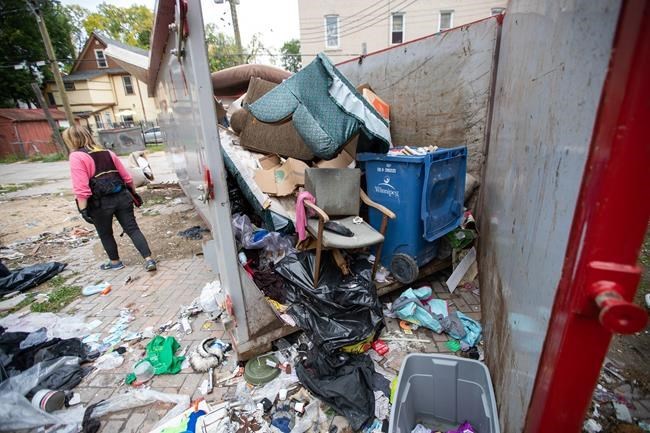WINNIPEG — Angela Klassen Janeczko calls out to a young woman sitting behind a building in downtown Winnipeg to see if she needs any water or food.
They know each other by name and Janeczko has seen the young Indigenous woman struggle with housing and addiction for more than year.
Janeczko works with the Bear Clan Patrol, a neighbourhood watch group in Winnipeg that walks through streets and alleys looking to help those most in need. She says they have seen rooming houses and apartment buildings become derelict. At the same time, rent has also gone up and nearby houses are selling for record amounts.
It is disproportionately affecting Indigenous people in the neighbourhood, she says, and many are ending up in tents tucked behind buildings, along the riverbank or in small community parks. The COVID-19 pandemic just exacerbated the problem, she adds.
“Treat people with humanity and respect,” Janeczko says, as she hands out some food to another person nearby.
Statistics Canada's latest release of 2021 census data shows the Indigenous population is still growing, although the pace has slowed, and is much younger than the rest of Canada. However, the data says, they are also struggling with housing in a system that's already stretched thin.
The census says there are 1.8 million Indigenous people in Canada, accounting for five per cent of the total population. The Indigenous population grew by 9.4 per cent from 2016 to 2021, almost twice the pace of the non-Indigenous population.
While the number of Indigenous people in insufficient housing decreased slightly, it is still much higher than the non-Indigenous population.
Almost one in six Indigenous people lived in a home in need of major repairs in 2021, a rate almost three times higher than for the non-Indigenous population, and more than 17 per cent of Indigenous people lived in crowded housing.
Statistics Canada says because of difficulties in collecting census data on First Nations and other Indigenous communities, some caution should be exercised in comparing census years. The agency says it made adjustments to track overall trends.
Wednesday’s census release comes as Prime Minister Justin Trudeau’s Liberal government set housing for Indigenous Peoples as a priority. It was also a part of the agreement between the minority Liberal government and the New Democrats.
The 2022 federal budget committed $4.3 billion over seven years to help improve Indigenous housing, a number the Assembly of First Nations says falls far short of what is needed. The national advocacy organization had asked to see $44 billion to deal with overcrowding and homes in dire need of repair on reserves.
Michael Yellow Bird, dean of the University of Manitoba's social work faculty, says it is a byproduct of colonization. Forced relocation, a loss of sovereignty and decades of underfunding have contributed to poverty and poor housing for Indigenous people. The trauma and displacement caused by residential schools is also a factor, he adds.
Housing on-reserve also doesn’t work the same as elsewhere, Bird explains, and it can be a complex administrative process for First Nations to work with Ottawa to tackle those long-standing issues.
The effect of unstable and overcrowded housing on- and off-reserve can be the same, Bird says. Poor housing is connected to major health issues, mental health problems, poor education outcomes and higher rates of suicide, he says.
“These things are all so connected,” Bird says. “It’s the demography of these things that we know, that these critical factors are causing a number of different kinds of disorders in communities.”
The Liberals have promised to develop an urban, rural and northern Indigenous housing strategy and have budgeted $300 million over five years so that the Canada Mortgage and Housing Corporation can work with Indigenous communities to build the plan.
Affordability has become an issue in many real estate markets in Canada, but Indigenous people are more likely than their non-Indigenous counterparts to be living in a low-income situation.
The census found 18.8 per cent of Indigenous people lived in a low-income household. The rate was highest among First Nations people, particularly those who lived on a reserve.
"Nearly one-quarter of Indigenous children 14 years of age and younger lived in a low-income household in 2021, which is over double the rate among non-Indigenous children," said Annie Turner, with the centre for Indigenous statistics and partnerships at Statistics Canada.
Research shows that Indigenous people are also disproportionately homeless.
Janeczko walks through an alley with a handful of volunteers as the call of “sharp” echoes each time they find a needle. The group picked up more than 325 needles in a couple of hours during the recent patrol. Not every person without a home has addictions, but it can be a way those community members cope, Janeczko says.
Winnipeg has the largest Indigenous population of any major city in Canada and it continues to grow. Janeczko says every level of government has committed to studying the housing problem, but the people most affected need help now.
A sign on a nearby garage reads that a person has permission to live there. The young man inside thanks the Bear Clan volunteers for food and water as they check on him. Inside the garage is a makeshift living area with a couch covered in blankets, a table and a handful of personal items.
Janeczko explains the property where the garage stands used to be a rooming house that had about 20 occupants. When the owner died it was abandoned, she says.
The housing needs in the neighbourhood are immense, so the loss of an affordable rental space left many people at risk of being on the street, she says.
“The housing need is here,” she says.
This report by The Canadian Press was first published Sept. 21, 2022.
Kelly Geraldine Malone, The Canadian Press
Note to readers: The photo caption for this story has been corrected. A previous version misidentified Matthew Gobert.




